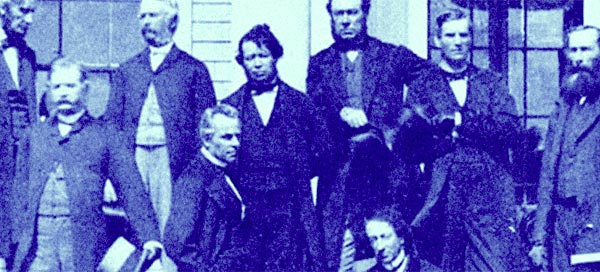Harper’s parliamentary reforms could solve some problems—and cause others
Bruce M. Hicks

Over the years, governments have tinkered with the parliamentary rules set by the Charlottetown conference, pictured here.
The Harper government has placed a bill before Parliament that would alter the formula for how seats are redistributed following the census. It would give Ontario, Alberta and British Columbia more seats in the House of Commons; naturally, Quebec and the Atlantic Canadian provinces are upset with this change as it diminishes their relative influence in Parliament.
Originally, Ontario was upset with the plan because it wanted the Commons to be even closer to representation by population. So vocal was Premier Dalton McGuinty in his opposition that the Harper government was forced to increase its offer to 18 new seats for Ontario after the next census, instead of the four additional seats as planned. Alberta will now get five instead of one, and B.C. seven instead of two. The increase and redistribution of parliamentary seats will provide some necessary repairs—greater representation for large, currently underserved, immigrant populations in the suburbs around Toronto, for instance—but it opens the door to bigger problems in the future.
Federalism is adopted by countries where there are strong regional identities or linguistic differences, in order to protect these minorities from the tyranny of the majority. A bicameral legislature—literally, “two chambers,” the house and the senate—then allows for two different approaches to representation: the lower chamber represents the majority of the population, while the upper chamber provides minority and regional counterbalance.
The Fathers of Confederation adopted this model in 1867, and established a House of Commons that would be largely “rep-by-pop”—on the condition that the French Canadian partners would receive equal representation in the Senate, and the creation of their own province in which French Canadians would be the majority.
Canada’s first Parliament in 1867 had 181 seats in the Commons: 82 for Ontario, 65 for Quebec, 19 for Nova Scotia, and 15 for New Brunswick. The Senate had 75 seats, divided equally between Ontario, Quebec and the Maritimes. But it soon became clear that the Senate had no capacity to represent regional, sectional and provincial interests as was intended. This is, in part, because senators are appointed by the prime minister and so are federally oriented; it’s also because over time unelected representatives have lost the credibility they need to participate in the legislative process.
The result is that the Senate has withered in its authority and importance, mostly rubber-stamping the laws that the House of Commons writes. This has forced the distribution of seats in the Commons—and thus the distribution of political power—to move away from representation by population in order to ensure regional and provincial demands can also be met. A 1974 constitutional provision passed by Parliament dictated that a province can never lose seats—which means the only way to balance things out is to add more.
So why tinker with the formula now? The obvious answer is there are votes to be won in these new seats, and these are voters the Conservatives have long been courting: suburban voters around Toronto and in the big western Canadian cities.
The other answer is that the Harper government has a democratic reform agenda. This agenda involves making the Senate elected on eight year terms and holding Commons elections every four years, with ridings distributed equally by population. Part of the Senate would be standing for election with the Commoners every four years. Sound familiar? This model is not from Westminster—it’s from Washington, D.C.
Most observers won’t know that, because each of these changes is contained in a separate piece of legislation. This is so the Supreme Court does not strike it down— which they surely would, given how radically it would alter the contract found in the constitution.
The problem with a piecemeal approach is that not everything will pass, and half-measures could mean trouble. It is quite possible that the only plank of the new system that will get adopted is the transition closer to representation by population for the House of Commons: more seats for B.C., Alberta and Ontario—at the expense of everyone else.
All of the eastern Canadian provinces would be diminished, but the prospects are most serious for Quebec. Without a reformed Senate, the protection Quebec was guaranteed at Confederation will be severely diminished. Undoubtedly there will be separatists in Quebec who will point out their weakened standing in the House of Commons, a trend that will continue to get worse based on current population projections. In such a scenario, separatists could argue the only political body that can be trusted to represent Quebec’s interest is the National Assembly—and it might be best to go it alone.